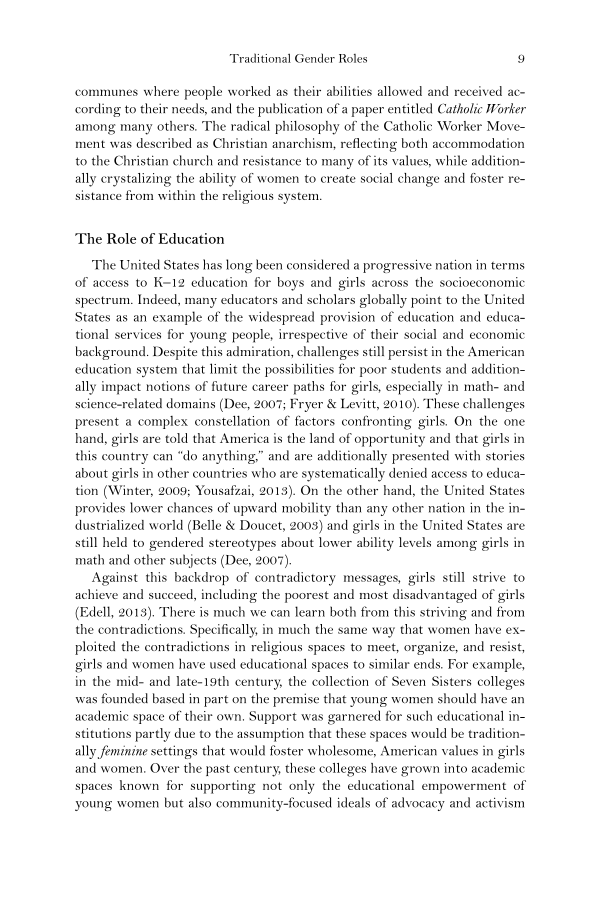Traditional Gender Roles 9 communes where people worked as their abilities allowed and received ac- cording to their needs, and the publication of a paper entitled Catholic Worker among many others. The radical philosophy of the Catholic Worker Move- ment was described as Christian anarchism, refl ecting both accommodation to the Christian church and resistance to many of its values, while addition- ally crystalizing the ability of women to create social change and foster re- sistance from within the religious system. The Role of Education The United States has long been considered a progressive nation in terms of access to K–12 education for boys and girls across the socioeconomic spectrum. Indeed, many educators and scholars globally point to the United States as an example of the widespread provision of education and educa- tional services for young people, irrespective of their social and economic background. Despite this admiration, challenges still persist in the American education system that limit the possibilities for poor students and addition- ally impact notions of future career paths for girls, especially in math- and science-related domains (Dee, 2007 Fryer & Levitt, 2010). These challenges present a complex constellation of factors confronting girls. On the one hand, girls are told that America is the land of opportunity and that girls in this country can “do anything,” and are additionally presented with stories about girls in other countries who are systematically denied access to educa- tion (Winter, 2009 Yousafzai, 2013). On the other hand, the United States provides lower chances of upward mobility than any other nation in the in- dustrialized world (Belle & Doucet, 2003) and girls in the United States are still held to gendered stereotypes about lower ability levels among girls in math and other subjects (Dee, 2007). Against this backdrop of contradictory messages, girls still strive to achieve and succeed, including the poorest and most disadvantaged of girls (Edell, 2013). There is much we can learn both from this striving and from the contradictions. Specifi cally, in much the same way that women have ex- ploited the contradictions in religious spaces to meet, organize, and resist, girls and women have used educational spaces to similar ends. For example, in the mid- and late-19th century, the collection of Seven Sisters colleges was founded based in part on the premise that young women should have an academic space of their own. Support was garnered for such educational in- stitutions partly due to the assumption that these spaces would be tradition- ally feminine settings that would foster wholesome, American values in girls and women. Over the past century, these colleges have grown into academic spaces known for supporting not only the educational empowerment of young women but also community-focused ideals of advocacy and activism
Document Details My Account Print multiple pages
Print
You have printed 0 times in the last 24 hours.
Your print count will reset on at .
You may print 0 more time(s) before then.
You may print a maximum of 0 pages at a time.














































































































































































































































































































